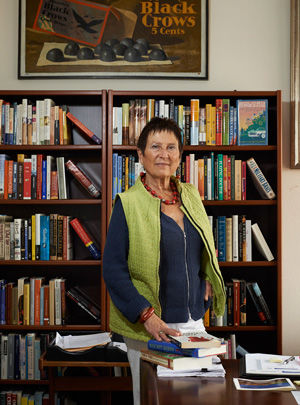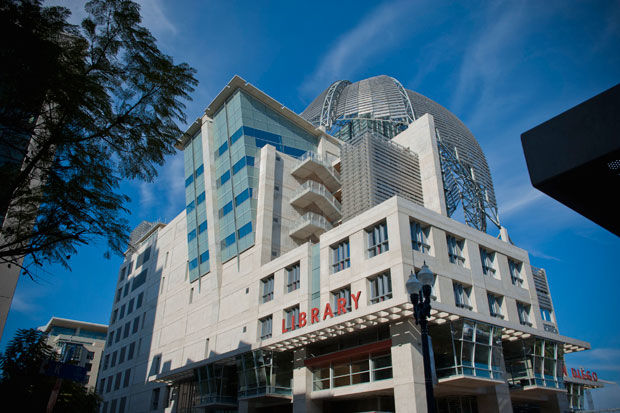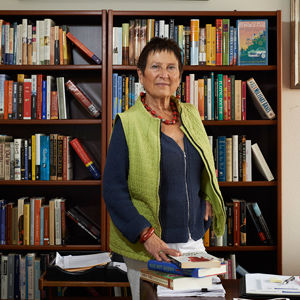
Sandra Dijkstra
Sandra Dijkstra
My mom always thought I “read too much.” Ironic, coming from a reading teacher, but her chief concern was that I be attractive and find a good mate. Still, all that early reading, from Nancy Drew to Jane Eyre, clearly made a difference, as my love for books grew from a guilty pleasure to a thriving livelihood.
Indeed, if there were another strong influence on me (besides my mother), it would have to be the location in which I found myself. Mine is very much a San Diego story, in that so many San Diegans and local institutions, private and public, seem to have brought me where I am today. Hillary Clinton famously said “It takes a village,” and, in my case, it took our city—and our coast!
Perhaps it all started when my lengthy graduate work at UCSD was wearing thin. I decided to please my mother and got my first real teaching job at Mesa College in the French Department. Soon thereafter, SDSU’s Women’s Studies Program, where I’d begun teaching as an adjunct, decided not to hire me as an assistant professor when an opening arose. That led me to approach the newly established San Diego office of Harcourt Brace Jovanovich, which also declined to hire me for an opening as associate editor. And then, when UCSD’s student newspaper outed me as a progressive professor, and no one from the Literature Department came to my defense (except for my husband, a colleague), I realized that I should go into full-time agenting.
Many of my initial successes with authors came directly from my San Diego connections and the community. For example, Lillian Faderman’s Surpassing the Love of Men: Romantic Friendship and Love Between Women from the Renaissance to the Present, which is still in print, was my first sale to a New York publisher (William Morrow). It was a book and a relationship birthed by UCSD Interlibrary Loan staffer Fran Newman, who urged me to meet Lillian when she heard I was starting a women writers’ group. Today, Lillian Faderman is the award-winning “Queen of Lesbian and Gay Studies,” currently writing a book on gay rights, the civil rights issue of our time, for Simon & Schuster—her biggest book yet.
Another San Diego connection resulted in Dessa Rose, originally a novella by Sherley Anne Williams, first published in Black-Eyed Susans. In 1984, I suggested to Sherley Anne, then a UCSD literature professor, that she consider expanding it into a novel. Now a classic in African-American Studies across the country, it also became a Lincoln Center play, though Sherley Anne never lived to see that, sadly.
And from North County, Janell Cannon’s Stellaluna came in as a manuscript with images, both created by Janell, which the then-local publisher (Harcourt Brace Jovanovich) said needed to be radically changed. Not having children and not being a reader of kids’ books, I felt they were wrong, but needed experts on my side. So, I went to the great bookseller Susan Malk (who now runs the Scripps Aquarium bookstore). Her White Rabbit bookstore on Girard in La Jolla boasted several excellent staff readers, all of whom proclaimed that our version would be “a Caldecott Award winner,” whereas the publisher’s preferred, bland version would be rejected by their store. The rest is history. The author’s draft of Stellaluna became one of the biggest-selling childrens’ books of that year, is now a classic, and led to a stellar book-writing and illustrating career for Janell Cannon.

The new Central Library
The new San Diego Central Library, designed by Rob Quigley
I also benefitted (as have many local authors) from the support of San Diego’s terrific independent booksellers, some of whom are sadly missed today. Family-owned Warwick’s in La Jolla strides on valiantly, the torch long ago passed from Barbara Christman to Adrian Newell. To this day Warwick’s is a must-stop for nationally touring authors. The much-missed Milane Christiansen created The Book Works, which became action central for political authors like Paul Krugman and literary stars like Chitra Divakaruni. Carole Carden, whose Del Mar-based Esmeralda was a gem (she now runs Solo in Solana Beach, which features design and architecture books, among many other wonderful things). From Coronado, Barbara Chambers carries on the great bookseller tradition at Bay Books, which she learned from Shirley Muller, while MaryElizabeth Hart’s Mysterious Galaxy does so well that she’s founded a sister store in Redondo Beach. And of course, the treasured D.G. Wills thrives still in La Jolla. I’m grateful for the many San Diego readers who still understand how important it is to support this family of booksellers, especially in the age of Amazon.
Of course, over the years, we fought our share of battles. The most notorious was the writing community’s threat to appear in the Copley lobby, Fahrenheit 451-style, carrying a coffin filled with the books of authors who wouldn’t get reviewed if the San Diego Union-Tribune shut down its Book Review. We won that one, at least for a few years. Book Review editors, especially Arthur Salm and Bob Pincus, and then Jim Chute, gave coverage to important authors’ books and visits. Today, we treasure John Wilkens and Peter Rowe at the U-T, though book coverage has shrunk to just one page. Looking back, both my agency and my authors would have had a tougher time without the support of book reviewers and feature writers like Ed Hutshing and Noel Osment. (Noel profiled Amy Tan for the U-T, to the great chagrin of Amy’s then-publisher, Putnam, which wanted to give the Los Angeles Times priority.)
Though not a local herself, Amy Tan has plenty of San Diego in her story, too. Just a few years into agenting (in 1989), I took to New York a proposal for a novel entitled The Joy Luck Club. Overnight, it became a bestseller. On the day of her paperback auction [when publishing houses try to outbid each other for the rights to the paperback edition of a bestselling book], Amy came to Del Mar so we could be together during the exciting process. Eight houses were participating (before today’s consolidation in publishing, which became “the Big Six,” and then “the Big Five” with the merging of Random House and Penguin), each wanting the privilege of acquiring it. As we sat on the deck of Il Fornaio that day 24 years ago, looking out at the Pacific, we couldn’t know that Amy would be making publishing and literary history—not only on that deal, but because the book itself would sell into so many countries (35!), and become a world classic.
Indeed, we are a family—we San Diego friends of the book—and, looking back, I have no regrets, only thanks, to each and every good and generous teacher, librarian, bookselling professional, author (and even my strong contrarian mother, and wonderful husband, author Bram Dijkstra), who supported my transition from reader, to teacher, to agent, having found lots of joy and luck here in San Diego.
As the new San Diego Central Library opens its doors, I’m reminded of how important libraries are to writers. Here’s Amy Tan, as a child, writing about “What the Library Means to Me”:
I love school because the many things I learn seem to turn on a light in the little room in my mind. I can see a lot of things I have never seen before. I can read many interesting books by myself now. I love to read. My father takes me to the library every two weeks, and I check five or six books out at a time. These books seem to open many windows in my little room. I can see many wonderful things outside. I always look forward to go to the library.
PARTNER CONTENT
The new San Diego Central Library opens September 28. Amy Tan’s new novel, The Valley of Amazement, will be released in November, and she’ll be appearing at Warwick’s in La Jolla on December 9.

















